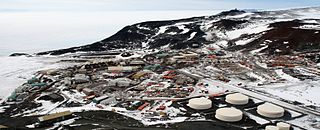
McMurdo Station is an American Antarctic research station on the southern tip of Ross Island, which is in the New Zealand–claimed Ross Dependency on the shore of McMurdo Sound in Antarctica. It is operated by the United States through the United States Antarctic Program (USAP), a branch of the National Science Foundation. The station is the largest community in Antarctica, capable of supporting up to 1,500 residents, and serves as one of three year-round United States Antarctic science facilities. All personnel and cargo going to or coming from Amundsen–Scott South Pole Station first pass through McMurdo. McMurdo Station continues to operate as the hub for American activities on the Antarctic continent. By road, McMurdo is 3 kilometres (1.9 mi) from New Zealand's smaller Scott Base.

The McMurdo Dry Valleys are a row of largely snow-free valleys in Antarctica, located within Victoria Land west of McMurdo Sound. The Dry Valleys experience extremely low humidity and surrounding mountains prevent the flow of ice from nearby glaciers. The rocks here are granites and gneisses, and glacial tills dot this bedrock landscape, with loose gravel covering the ground. It is one of the driest places on Earth and is sometimes claimed to have not seen rain in nearly two million years, though this is highly unlikely and several anecdotal accounts of rainfall within the Dry Valleys exist.
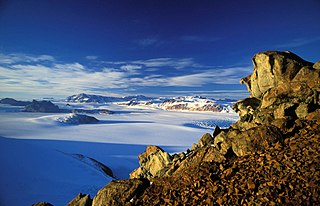
The Transantarctic Mountains comprise a mountain range of uplifted rock in Antarctica which extends, with some interruptions, across the continent from Cape Adare in northern Victoria Land to Coats Land. These mountains divide East Antarctica and West Antarctica. They include a number of separately named mountain groups, which are often again subdivided into smaller ranges.

The McMurdo Sound is a sound in Antarctica, known as the southernmost passable body of water in the world, located approximately 1,300 kilometres (810 mi) from the South Pole.

Lake Fryxell is a frozen lake 4.5 kilometres (2.8 mi) long, between Canada Glacier and Commonwealth Glaciers at the lower end of Taylor Valley in Victoria Land, Antarctica. It was mapped in the early 1900s and named during Operation Deep Freeze in the 1950s. There are several forms of algae living in the waters and a weather station located at the lake.

The United States Antarctic Program is an organization of the United States government which has a presence in the Antarctica continent. Founded in 1959, the USAP manages all U.S. scientific research and related logistics in Antarctica as well as aboard ships in the Southern Ocean.

An ice pier or ice wharf is a man-made structure used to assist the unloading of ships in Antarctica. It is constructed by pumping seawater into a contained area and allowing the water to freeze. By repeating this procedure several times, additional layers are built up. The final structure is many metres in thickness, and strong enough to support container trucks. Operation Deep Freeze personnel constructed the first floating ice pier at Antarctica’s southernmost sea port at McMurdo Station in 1973. Ice piers have been in use each summer season since, at McMurdo's natural harbor at Winter Quarters Bay located at 77°50′S166°40′E. The harbor is positioned on the southern tip of Ross Island.

Benmoreite is a volcanic rock of intermediate composition. It is a silica-undersaturated sodium-rich variety of trachyandesite and belongs to the alkaline suite of igneous rocks.
Euphausia crystallorophias is a species of krill, sometimes called ice krill, crystal krill, or Antarctic coastal krill. It lives in the coastal waters around Antarctica, further south than any other species of krill. The specimens for the species' original description were collected through holes cut in the ice by Robert Falcon Scott's Discovery Expedition, several thousand having been donated by Thomas Vere Hodgson.
Metavolcanic Mountain is a large flat-topped mountain, 2,480 metres (8,140 ft) high, located 5 nautical miles north of the Hatcher Bluffs on the east side of Reedy Glacier, Antarctica.

Limacina rangii is a species of swimming sea snail in the family Limacinidae, which belong to the group commonly known as sea butterflies (Thecosomata).
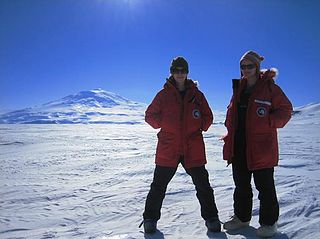
Kelly Jemison is an American academic geologist specializing in Antarctic diatoms. She studied at Florida State University, participated in the ANDRILL Project, and in 2011 was awarded the Antarctica Service Medal. She currently works as a Geologist for Bureau of Ocean Energy Management in Anchorage, Alaska.

Abas is an extinct genus of diatoms consisting of only one known species: Abas wittii. Originally observed as a fossil genus classified with diatom spore forms under the name Syringidium. Abas was observed to be live from the Eocene to Oligocene epoch appearing in tropical sites.
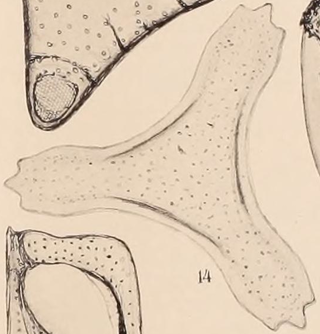
Trinacria is an extinct genus of diatoms present during the early Eocene, named for its triskelion shape.
Deneb Karentz is full-time faculty, professor, and chair of the Biology Department at University of San Francisco. Her research focuses on the ultraviolet photobiology of marine organisms and understanding their strategies for protection from UV exposure, particularly in relation to the ecological implications of Antarctic ozone depletion.

Christina Riesselman is an American paleoceanographer whose research focus is on Southern Ocean response to changing climate.

Phyllophora antarctica is a species of red alga in the family Phyllophoraceae. It is native to Antarctica where it grows in dim light on the underside of sea ice. Some of it becomes detached and accumulates in drifts on the seabed. Many different organisms live attached to the fronds or among them.
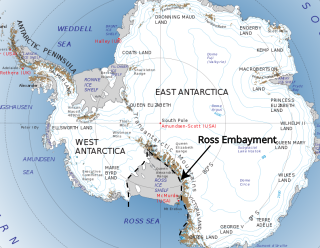
The Ross Embayment is a large region of Antarctica, comprising the Ross Ice Shelf and the Ross Sea, that lies between East and West Antarctica.

Diatoms belong to a large group called the heterokonts, which include both autotrophs such as golden algae and kelp; and heterotrophs such as water moulds. The classification of heterokonts is still unsettled: they may be designated a division, phylum, kingdom, or something intermediate to those. Consequently, diatoms are ranked anywhere from a class, usually called Diatomophyceae or Bacillariophyceae, to a division (=phylum), usually called Bacillariophyta, with corresponding changes in the ranks of their subgroups.

Lake Washburn is a lake that formerly existed in the Taylor Valley, McMurdo Dry Valleys, Antarctica. It formed when climatic changes and an expansion of ice caused the flooding of the valley, between 23,000 and 8,340 radiocarbon years ago. Its extent and elevation are unclear but Lake Bonney and Lake Fryxell are considered to be its present-day remnant.















